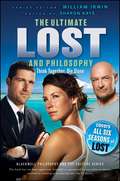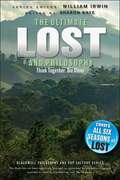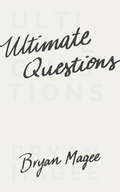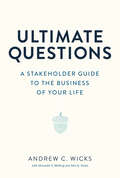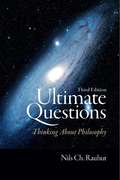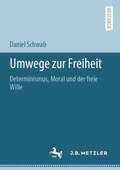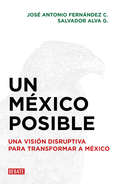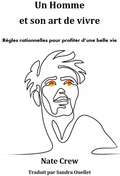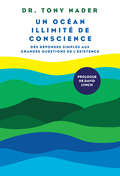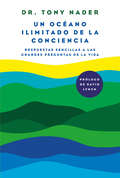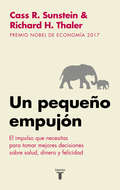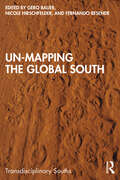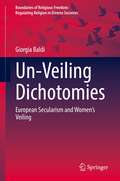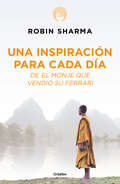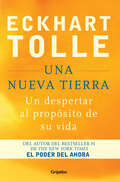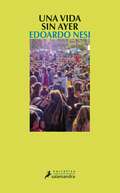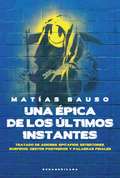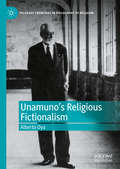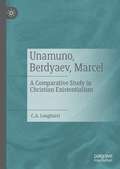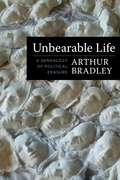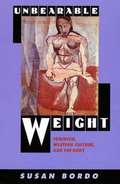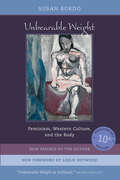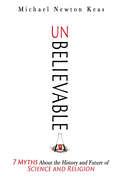- Table View
- List View
Ultimate Lost and Philosophy: Think Together, Die Alone
by Sharon KayeAn action-adventure story with more than a touch of the metaphysical, Lost forces viewers to ask difficult questions of themselves just as the story asks difficult questions of its characters. Ultimate Lost and Philosophy helps you explore the deeper meaning and philosophical questions hidden within every complex twist and turn in the historic TV show's entire six-season run.
Ultimate Lost and Philosophy: Think Together, Die Alone (The Blackwell Philosophy and Pop Culture Series #35)
by William IrwinExpanded and up-to-date-the ultimate guide that explores meaning and philosophy of all six seasons of Lost Lost is more than just a popular television show; it's a complex examination of meaningful philosophical questions. What does good versus evil mean on the island? Is it a coincidence that characters John Locke and Desmond David Hume are named after actual philosophers? What is the ethics of responsibility for Jack? An action-adventure story with more than a touch of the metaphysical, Lost forces viewers to ask difficult questions of themselves just as the story asks difficult questions of its characters. Ultimate Lost and Philosophy helps you explore the deeper meaning and philosophical questions hidden within every complex twist and turn in the historic show's entire six-season run. Includes every season of Lost, including 2010's final, highly anticipated season Connects events on the show to core philosophical issues such as truth, identity, and morality Explores a host of intriguing topics such as time travel, freedom, love, and loss For fans of Lost who are interested in what the show reveals about ourselves and the human condition, Ultimate Lost and Philosophy is an entertaining, informative, and enlightening resource.
Ultimate Questions
by Bryan MageeWe human beings had no say in existing--we just opened our eyes and found ourselves here. We have a fundamental need to understand who we are and the world we live in. Reason takes us a long way, but mystery remains. When our minds and senses are baffled, faith can seem justified--but faith is not knowledge. In Ultimate Questions, acclaimed philosopher Bryan Magee provocatively argues that we have no way of fathoming our own natures or finding definitive answers to the big questions we all face.With eloquence and grace, Magee urges us to be the mapmakers of what is intelligible, and to identify the boundaries of meaningfulness. He traces this tradition of thought to his chief philosophical mentors--Locke, Hume, Kant, and Schopenhauer--and shows why this approach to the enigma of existence can enrich our lives and transform our understanding of the human predicament. As Magee puts it, "There is a world of difference between being lost in the daylight and being lost in the dark."The crowning achievement to a distinguished philosophical career, Ultimate Questions is a deeply personal meditation on the meaning of life and the ways we should live and face death.
Ultimate Questions: A Stakeholder Guide to the Business of Your Life
by Professor Andrew C. Wicks Alexander S. Bleiberg Professor John K. NolanThe accumulated wisdom of a beloved business professor&’s signature course Who are we, and who am I? Why are we here, and why am I here? What is the good life, and what is my good life? How should I get along with others? For years, business ethics professor Andrew Wicks pursued these lines of inquiry in his perennially popular course &“Ultimate Questions and Creating Value for Stakeholders.&” In this book, he presents the core ideas of the course to a general audience. Touching on a variety of possible answers—from philosophers, scientists, and more—without advocating for any single position, the book reminds readers that these questions are present in our lives every day and all the time. When we consider them consciously, we can identify our existing answers and craft new ones as we grow and change. They are at the core of what it means to live a fully realized life. And as the world becomes increasingly polarized, ultimate questions emerge as a critical lens through which to relate across difference. With gentle guidance, this book encourages the kind of difficult, vulnerable conversations that help us learn about and interact with each other more authentically—and offers tips on how to do so in a way that feels more like everyday dialogue among peers than hostile confrontations among rivals. While this book is about finding individual answers to these questions, it is also about business and business leadership. Business is a fundamentally human activity, in which people work together to make themselves and each other better off. When business leaders and students ask these probing questions, it leads to more understanding, more collaboration, and better business outcomes. The book is deeply tied to stakeholder theory, which posits that a business succeeds when it serves a wide range of people in its value chain: customers, suppliers, employees, financiers, community members, and more. Considering these questions with members of all these groups enables business leaders to better understand how to serve their stakeholders and find new ways to generate prosperity—not just for investors or owners, but for all involved in the value-creation process of a company. At once conceptual and down-to-earth, Ultimate Questions inspires reflection and offers tools to better understand ourselves and others, to build the kinds of connection and reciprocity needed to lead in business and to live with authenticity and purpose.
Ultimate Questions: Thinking About Philosophy, Third Edition
by Nils Ch. RauhutThis inexpensive and brief text examines the main problems in contemporary philosophy and uses more than 100 “Food for Thought” exercises to promote critical thinking and help students become active learners of philosophy. The book is intended for use by professors teaching a problems-oriented course, but is structured to appeal to any reader willing to explore subjects such as free will, personal identity, existence of God, and more. <P><P>Ultimate Questions explores how the timeless problems of Western philosophy are located inside our ordinary ways of thinking and being. It encourages readers to think about philosophy first-hand by using vivid and engaging examples. It also introduces readers to prominent up-to-date theories being applied to the same problems encountered by contemporary analytic philosophers. After reading this text, students will gain a better sense of how mysterious their own natures really are.
Ultrasonic (Essays)
by Steven ChurchA well-written collection of essays by a writer, professor, father of two. Each essay is managed differently in presentation on the page, leading the reader to wonder what might be next.
Umwege zur Freiheit: Determinismus, Moral und der freie Wille
by Daniel SchwabIm ersten Teil der Abhandlung soll mit P.F. Strawson (und über ihn hinaus) der These das Wort geredet werden, dass unsere freiheitsimplizierende moralische Praxis, anders als z.B. der freiheitsskeptische Neurophysiologe W. Singer, aber auch sein freiheitsliebender Gegenspieler G. Keil glauben, sich von der Annahme des naturgesetzlichen Determinismus keineswegs beeindruckt zeigen muss. Die Binnensicht des uns gewohnten zwischenmenschlichen Miteinanders ist, zeigt Strawson, von der Warte der objektiven Wissenschaften her nicht zu hintergehen, Entscheidungen über die Gestaltung jenes Miteinanders sind begrifflich unabhängig von der Entscheidung der Determinismusfrage. Im zweiten Teil soll die dieser Diagnose entsprechende Vereinbarkeitsthese mithilfe von Kants Erscheinungslehre epistemologisch fundiert und auf mögliche Folgen für unser Selbstverständnis als moralische Wesen hin untersucht werden.
Un México posible: Una visión disruptiva para transformar a México
by José Antonio Fernández C. Salvador Alva G.Una perspectiva de cambio para que nos convirtamos en el país que deseamos, capaz de transitar por el siglo XXI con una visión incluyente, eficaz y entusiasta. México está lleno de gente talentosa y capaz, y posee un vibrante espíritu emprendedor. Sin embargo, el modelo actual de desarrollo no responde a las nuevas circunstancias y paradigmas de las economías basadas en el conocimiento y la innovación, para las que atraer, retener y desarrollar talento constituye el motor de la movilidad social y el bienestar. Debemos replantearnos de manera urgente hacia dónde vamos y qué modelo de país deseamos impulsar para enfrentar los retos presentes y futuros. En este libro, José Antonio Fernández C. y Salvador Alva G., con una destacada trayectoria en transformación organizacional, ofrecen su perspectiva de cambio para que nos convirtamos en el país que deseamos, capaz de transitar por el siglo XXI con una visión incluyente, eficaz y entusiasta. Un México posible no es un listado de políticas públicas específicas con metas e indicadores tradicionales, que en el fondo repiten los patrones de antaño. Es, por contraste, un planteamiento disruptivo para transformarnos, que nos inspira y unifica en una visión compartida que busca ventajas competitivas para destacar, mediante una nueva organización enfocada en el empoderamiento del ciudadano. La obra, así, fomenta una cultura y valores basados en el esfuerzo y el mérito de cada mexicano, y busca rescatar lo mejor de nuestra gente para, por fin, desarrollarnos plenamente como nación.
Un homme et son art de vivre: Règles rationnelles pour profiter d’une belle vie
by Nate CrewCe livret est le code brut d’un individualiste. Il ne s’agit pas d’une nouvelle philosophie, mais d’un guide simple et pratique pour les modes de pensée et d’action les plus bénéfiques de l’homme. Neuf règles générales directes résument les principes de base de l’éthique, de l’auto-détermination et notamment de tirer le meilleur parti de la vie. Initialement écrit pour les fils de l’auteur, sa sagesse et sa validité en font un atout pour toute personne nécessitant des valeurs rationnelles pour vivre.
Un océan illimité de conscience
by Dr. Tony NaderDes réponses simples aux grandes questions de l'existence. Prologue de David Lynch. «Dans ce livre qui fera date, les idées que développe le Dr Nader ont le pouvoir de changer le monde. Il apporte des réponses fondamentales aux questions qui ont fasciné et intrigué depuis longtemps philosophes et scientifiques. Qu'est-ce que la conscience, sommes-nous libres ? Comment réussir au mieux sa vie, réaliser ses désirs, susciter la paix et l'harmonie entre les êtres humains et les pays ? À toutes ces questions, il apporte des solutions fondées sur un paradigme fondamental et simple qui unifie l'esprit, le corps et l'environnement en un océan unique d'Être pur, de conscience pure. Un livre que toute personne à la recherche de la vérité ultime et absolue se doit de lire.»David Lynch «Je veux que toute le monde sache ce qu'est la conscience et comment la développer pour profiter du plein potentiel de la vie individuelle et sociale.»Dr. Tony Nader
Un océano ilimitado de la conciencia: Respuestas sencillas a las grandes preguntas de la vida
by Dr. Tony NaderFigura central de las fundaciones David Lynch y Maharishi, neurocientífico graduado en Harvard, reconocido erudito védico y referente mundial de la Meditación Trascendental™, el Dr. Tony Nader formula en este libro una serie de preguntas existenciales fundamentales (¿cuál es nuestro propósito en la vida?, ¿tenemos verdadero control sobre nuestros destinos?) y, a través del estudio de la Conciencia, nos acerca respuestas con beneficios prácticos que aspiran a darnos esclarecimiento, paz y plenitud. «En este libro histórico, el Dr. Tony Nader presenta ideas que pueden cambiar el mundo. Propone soluciones profundas a preguntas que han fascinado e intrigado durante mucho tiempo a filósofos y científicos. ¿Qué es la Conciencia, tenemos libertad? ¿Cómo sacar lo mejor de la vida, cumplir los deseos y crear paz y armonía entre los pueblos y las naciones? Ofrece estas soluciones, basadas en un paradigma subyacente simple, que unifica la mente, el cuerpo y el medio ambiente en un océano de Ser puro, Conciencia Pura. Una lectura obligada para cualquier buscador de respuestas a los misterios de la vida, a la verdad absoluta y última.» David Lynch «Quiero que todos sepan qué es la Conciencia y cómo desarrollarla para disfrutar de todo el potencial de la vida individual y social.» DR. Tony Nader ¿Hay algún propósito oculto en la vida, un diseño secreto, una lógica significativa, un objetivo que alcanzar? ¿De dónde venimos y adónde vamos después de irnos? ¿Por qué deberíamos estar luchando? ¿Podemos elegir? ¿Somos libres o esclavos del destino, de las leyes de la naturaleza o de Dios? Como seres conscientes que desean tomar el control de sus vidas, estas preguntas son fundamentales; y todos terminan haciendo suposiciones o suscribiéndose firmemente a las creencias sobre muchas de ellas. Esas convicciones se convierten en nuestra subyacente "visión del mundo" que influye en todo lo que hacemos. Me volqué al estudio de la medicina, la psiquiatría y la neurología para comprender por qué, si bien somos tan similares, podemos ser tan diferentes en nuestras opiniones, mentalidad y puntos de vista. Pero las respuestas a mis preguntas fundamentales eran demasiado complejas y abstractas para la investigación científica. Fue la Meditación Trascendental™ lo que me permitió explorarlas a través de la experiencia directa, en lugar del análisis y la deducción. Este libro está dedicado a todos los buscadores de conocimiento, científicos, filósofos, maestros, líderes sabios y guías que investigan los secretos del funcionamiento de la naturaleza y el esfuerzo por mejorar la vida en la Tierra.
Un pequeño empujón: El impulso que necesitas para tomar mejores decisiones sobre salud, dinero y felicidad
by Cass R. Sunstein Richard H. ThalerEl libro que inspiró a Barack Obama los fundamentos de la política al demostrar el poder de un pequeño empujón. Por el Premio Nobel de Economía 2017 Richard H. Thaler. En Un pequeño empujón, considerado ya un clásico y uno de los mejores libros sobre economía y política de las últimas décadas, Cass R. Sunstein y Richard H. Thaler, premio Nobel de Economía, observan cómo nuestras percepciones y decisiones dependen del modo en que se organizan ante nosotros las diferentes opciones. Gobiernos y empresas, pero también padres, profesores y médicos, se convierten así en una especie de «arquitectos de la elección». A través de leves impulsos, conscientes, a menudo invisibles y cuyo coste económico y político es irrisorio, las personas e instituciones públicas o privadas pueden incentivar sin mermar la libertad de elección de los ciudadanos, y obtener así grandes logros en relación con la sanidad pública, las finanzas o la lucha contra la desigualdad. Un libro esencial para quienes formulan nuestras políticas públicas, pero cuya aplicabilidad en nuestras vidas cotidianas es sorprendente y maravillosamente eficaz. Críticas:«¿Cuántas veces se encuentra uno con un libro a la vez importante y divertido, práctico y profundo? De lectura obligada para quien quiera ver mejorar el funcionamiento de nuestras mentes y nuestra sociedad».Daniel Kahneman, Premio Nobel de Economía y autor de Pensar rápido, pensar despacio «Me entusiasmaeste libro. Es uno de los pocos que han cambiado de un modo trascendente mi manera de ver el mundo».Steve Levitt, autor de Freakonomics «El libro más importante que he leído en veinte años».Barry Schwartz, The American Prospect«Fabuloso. Cambiará tu forma de pensar, no solo sobre el mundo que te rodea y algunos de sus mayores problemas, sino también sobre ti mismo».Michael Lewis, autor de La gran apuesta y Deshaciendo errores
Un-Gandhian Gandhi: The Life and Afterlife of the Mahatma
by Claude MarkovitsThis major study reconsiders the creation of the Gandhian legend through the myriad texts and images that helped spread it through both India and the Western world.
Un-Mapping the Global South (Transdisciplinary Souths)
by Fernando Resende Gero Bauer Nicole HirschfelderThis book offers new approaches and insights into the ongoing and topical discussions on the concepts and definitions of the global south. Instead of adding to the debates about how to properly define the "global south" as such, it aims at emphasising concrete experiences and accounts of (post-)colonial dislocation and disidentification as both a starting point and linchpin for the subsequent exploration. It brings into conversation theories and interrogations of the "global south" with specific local studies, without presenting them as the romanticised "other" or as "non-western" narratives. As a bold initiation of future conversations on issues that both directly and indirectly affect ideas about the global south, the volume will be of great interest to scholars and researchers of critical theory, literary and cultural studies, and global south studies.
Un-Veiling Dichotomies: European Secularism and Women’s Veiling (Boundaries of Religious Freedom: Regulating Religion in Diverse Societies)
by Giorgia BaldiThis book analyzes the implication of secular/liberal values in Western and human rights law and its impact on Muslim women. It offers an innovative reading of the tension between the religious and secular spheres. The author does not view the two as binary opposites. Rather, she believes they are twin categories that define specific forms of lives as well as a specific notion of womanhood. This divergence from the usual dichotomy opens the doors for a reinterpretation of secularism in contemporary Europe. This method also helps readers to view the study of religion vs. secularism in a new light. It allows for a better understanding of the challenges that contemporary Europe now faces regarding the accommodation of different religious identities. For instance, one entire section of the book concerns the practice of veiling and explores the contentious headscarf debate. It features case studies from Germany, France, and the UK. In addition, the analysis combines a wide range of disciplines and employs an integrated, comparative, and inter-disciplinary approach. The author successfully brings together arguments from different fields with a comparative legal and political analysis of Western and Islamic law and politics. This innovative study appeals to students and researchers while offering an important contribution to the debate over the role of religion in contemporary secular Europe and its impact on women’s rights and gender equality.
Una inspiración para cada día
by Robin SharmaEn Una inspiración para cada día, Robin Sharma destila los conceptos más reveladores y significativos de su best seller El monje que vendió su Ferrari y de los títulos que siguieron a este éxito internacional, y los reúne en un calendario perpetuo de fácil lectura, diseñado para convertir en extraordinario cada uno de los días de nuestra vida.Un obra que se convertirá en un compañero vitalicio en tu camino hacia la excelencia.
Una nueva Tierra: Un despertar al propósito de su vida
by Eckhart TolleSi usted ya se ha iniciado en el proceso del despertar, éste se acelerará y se intensificará con la lectura de este maravilloso libro. "El despertar espiritual no es ya una opción sino una necesidad, si queremos que la humanidad y el planeta sobrevivan." ECKHART TOLLE El poder del ahora consagró a Eckhart Tolle como uno de los más grandes maestros de la literatura espiritual de nuestros días. Después de casi ocho años de espera, esta continuación, nos brinda de nuevo un mensaje profundo e inspirador a todos sus lectores. Eckhart Tolle nos enseña en Una nueva Tierra que tenemos la oportunidad de construir un mundo nuevo y mejor. Esto supone una revisión radical del papel de la conciencia, identificada con el propio ego, que debería convertirse en el instrumento para una comprensión distinta y profunda sobre quiénes somos. Para que esto ocurra, las estructuras de la mente humana necesitarían experimentar una transformación. En Una nueva Tierra, Tolle muestra cómo puede producirse dicha transformación, no sólo en nosotros sino en el mundo que nos rodea. Cuando revela la naturaleza de este cambio, Tolle describe minuciosamente cómo actúa nuestro ego y, a partir de ese conocimiento, el autor nos guía de forma muy práctica hacia la nueva conciencia, que nos llevará a la experiencia de nuestro ser más profundo y nos permitirá descubrir que somos infinitamente mejores de lo que pensamos.
Una vida sin ayer
by Edoardo NesiEdoardo Nesi, fiel a su estilo, recurre una vez más a su particular estilo, mezcla de testimonio, análisis y elaboración narrativa, para dirigir hacia el futuro una mirada convincente, cargada de entusiasmo e ilusión, sin la rémora de la nostalgia por un pasado esplendoroso que sabemos irrepetible. El relato comienza con un repaso a los días de gloria de una industria próspera, del prestigio del «Made in Italy», hasta la irrupción de una crisis que parece haber agotado la riqueza y el bienestar de un país. En este punto, se presentan dos posibilidades: abandonarse a la contemplación del ocaso o buscar en el presente los elementos para empezar a construir un futuro mejor. Nesi elige esta segunda vía y se dirige a los hijos, a los jóvenes en quienes recaerá la responsabilidad de levantar el país. Una generación que heredará un mundo más pobre que el que recibieron de sus padres, además de una realidad profundamente diversa, arbitraria y cambiante. Ellos deberán olvidar el ayer para atacar el mañana; necesitarán armarse de ideas renovadas -que sus padres ni siquiera deberían intentar comprender- para convertirlas en realidades, y el pasado sólo les servirá para descifrar el presente y proyectar un nuevo porvenir. Imaginar una sociedad que no se base en la avaricia y el individualismo sino en las ideas, en la capacidad emprendedora y en la generosidad es el alegato de Edoardo Nesi, un mensaje que no puede dejar indiferente a ningún lector comprometido y preocupado por la situación actual. Reseñas:«Un texto que nos agarra por las solapas y nos arrastra, con la potencia de una escritura de alta intensidad, que nos conduce a interrogarnos y reflexionar [...] sobre la Italia que se ha terminado y sobre cómo enderezarla.»TTL, La Stampa «Nesi es un apasionado estudioso del alma humana [...]. La modernidad de su posición intelectual le impide quedarse atascado en la contemplación de un mundo que va a la deriva.»La Sicilia «Narración [...] y panfleto combinados con gran fuerza y tensión comunicativa.»Il Messaggero «Una vida sin ayer propone una receta para salir del abismo que relata en La historia de mi gente. En sus páginas vuelven a mezclarse con fluidez la narración, la crónica, el ensayo, el panfleto y la autobiografía.»Panorama «Una prosa cálida, espontánea, sin neurosis demostrativas [...] alejada de cualquier retórica y al mismo tiempo ambiciosa y visionaria.»La Repubblica «Un mensaje políticamente incorrecto con respecto al buenismo imperante. Un título con capacidad de convertirse en el emblema de una generación.»La Nazione Firenze
Una épica de los últimos instantes: Tratado de adioses. Epitafios. Estertores. Suspiros. Gestos postreros y palabras
by Matías BausoEscritores y deportistas, cómicos y políticos, divas y luchadoras,héroes y asesinos... todos mueren. Y todos, en general por acto, perotambién por omisión, se despiden de este mundo de alguna manera,producen un último gesto. Este libro cataloga distintas formas demarcharse, con las «últimas palabras» como eje, como una de las bellasartes, como género literario. Hay personas que elucubraron durante años la frase con la que se iban adespedir. Otros siguieron su naturaleza y murieron tal como vivieron,sin traicionar su esencia. Hay muertes naturales y las hay torpes, lashay esperadas e insólitas, y también hay formas de morir íntimamenteligadas a formas de matar. Y todas, sin excepción, dicen algo.
Unamuno's Religious Fictionalism (Palgrave Frontiers in Philosophy of Religion)
by Alberto OyaThis book provides a coherent and systematic analysis of Miguel de Unamuno’s notion of religious faith and the reasoning he offers in defense of it. Unamuno developed a non-cognitivist Christian conception of religious faith, defending it as being something which we are all naturally lead to, given our (alleged) most basic and natural inclination to seek an endless existence. Illuminating the philosophical relevance this conception still has to contemporary philosophy of religion, Oya draws connections with current non-cognitivist notions of religious faith in general, and with contemporary religious fictionalist positions more particularly. The book includes a biographical introduction to Miguel de Unamuno, as well as lucid and clear analyses of his notions of the ‘tragic feeling of life’, his epistemological paradigm, and his naturally founded religious fictionalism. Revealing links to current debates, Oya shows how the works of Unamuno are still relevant and enriching today
Unamuno, Berdyaev, Marcel: A Comparative Study in Christian Existentialism
by C. A. LonghurstThis book seeks to examine the mutual interplay between existentialism and Christian belief as seen through the work of three existentialist thinkers who were also committed Christians - a Spaniard (Miguel de Unamuno), a Russian (Nikolai Berdyaev), and a Frenchman (Gabriel Marcel). They are compared with each other and with leading non-religious existentialists. The major themes studied include reason, freedom, the self, belief, hope, love, suffering, and immortality.
Unbearable Life: A Genealogy of Political Erasure (Insurrections: Critical Studies in Religion, Politics, and Culture)
by Arthur BradleyIn ancient Rome, any citizen who had brought disgrace upon the state could be subject to a judgment believed to be worse than death: damnatio memoriae, condemnation of memory. The Senate would decree that every trace of the citizen’s existence be removed from the city as if they had never existed in the first place. Once reserved for individuals, damnatio memoriae in different forms now extends to social classes, racial and ethnic groups, and even entire peoples. In modern times, the condemned go by different names—“enemies of the people;” the “missing,” the “disappeared,” “ghost” detainees in “black sites”—but they are subject to the same fate of political erasure.Arthur Bradley explores the power to render life unlived from ancient Rome through the War on Terror. He argues that sovereignty is the power to decide what counts as being alive and what does not: to make life “unbearable,” unrecognized as having lived or died. In readings of Augustine, Shakespeare, Hobbes, Robespierre, Schmitt, and Benjamin, Bradley asks: What is the “life” of this unbearable life? How does it change and endure across sovereign time and space, from empires to republics, from kings to presidents? To what extent can it be resisted or lived otherwise? A profoundly interdisciplinary and ambitious work, Unbearable Life rethinks sovereignty, biopolitics, and political theology to find the radical potential of a life that neither lives or dies.
Unbearable Weight: Feminism, Western Culture, and the Body
by Susan BordoFantastic study of women and their bodies. This 10th anniversary edition has a new preface by the author plus a foreword by Leslie Haywood, feminist scholar superstar, an authority on women athletes and body builders. When originally published in 1993, it made the list of NYT Notable Books of the Year.
Unbearable Weight: Feminism, Western Culture, and the Body
by Susan Bordo"Unbearable Weight is brilliant. From an immensely knowledgeable feminist perspective, in engaging, jargonless (!) prose, Bordo analyzes a whole range of issues connected to the body—weight and weight loss, exercise, media images, movies, advertising, anorexia and bulimia, and much more—in a way that makes sense of our current social landscape—finally! This is a great book for anyone who wonders why women's magazines are always describing delicious food as 'sinful' and why there is a cake called Death by Chocolate. Loved it!"—Katha Pollitt, Nation columnist and author of Subject to Debate: Sense and Dissents on Women, Politics, and Culture (2001)
Unbelievable: 7 Myths About the History and Future of Science and Religion
by Michael Newton KeasUnbelievable explodes seven of the most popular and pernicious myths about science and religion. Michael Newton Keas, a historian of science, lays out the facts to show how far the conventional wisdom departs from reality. He also shows how these myths have proliferated over the past four centuries and exert so much influence today, infiltrating science textbooks and popular culture. The seven myths, Keas shows, amount to little more than religion bashing—especially Christianity bashing.Unbelievable reveals: · Why the “Dark Ages” never happened · Why we didn’t need Christopher Columbus to prove the earth was round · Why Copernicus would be shocked to learn that he supposedly demoted humans from the center of the universe · What everyone gets wrong about Galileo’s clash with the Church, and why it matters today · Why the vastness of the universe does not deal a blow to religious belief in human significance · How the popular account of Giordano Bruno as a “martyr for science” ignores the fact that he was executed for theological reasons, not scientific ones · How a new myth is being positioned to replace religion—a futuristic myth that sounds scientific but isn’t In debunking these myths, Keas shows that the real history is much more interesting than the common narrative of religion at war with science. This accessible and entertaining book offers an invaluable resource to students, scholars, teachers, homeschoolers, and religious believers tired of being portrayed as anti-intellectual and anti-science.
